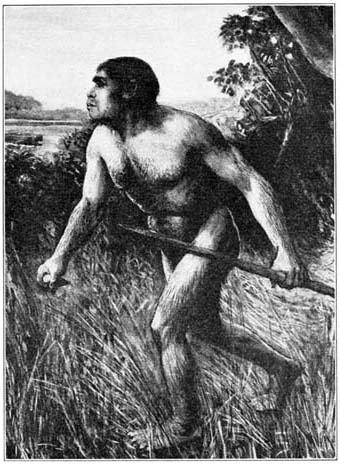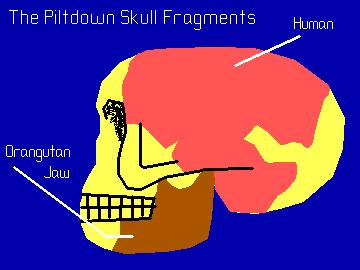Piltdown: The Man that Never Was
|

Hinton
(left) and Dawson (right) at the Piltdown site.
|
For forty years they were considered one of the
archaeological finds of the century: A fragment of jaw and a
part of a skull that could prove man evolved from the apes.
They were the bones of Eoanthropus dawsoni found near
Piltdown Common in Sussex. The bones of the "Missing Link."
Not.
Since 1953 the name "Piltdown" hasn't been associated
with great scientific discovery, but great scientific fraud.
It was in that year that a group of scientists, lead by Kenneth
Page Oakley, attempted to use the new method of fluorine testing
to get a more exact date on the bones. What the test showed
surprised them: The jaw was modern and the skull only six hundred
years old.
Additional analysis soon confirmed the fluorine
tests. The jaw was really that of an orangutan. It had been
filed down and parts that might have suggested it's simian origin
were broken off. Both pieces had been treated to suggest great
age.
Fooling
the Experts
Piltdown was proclaimed genuine by several of
the most brilliant British scientists of the day: Arthur
Smith Woodward, Arthur Keith and Grafton Elliot
Smith. How did these faked fragments of bone fool the best
scientific minds of the time? Perhaps the desire to be part
of a great discovery blinded those charged with authenticating
it. Many English scientists felt left out by discoveries on
the continent. Neanderthal had been found in Germany in 1856,
and Cro-Magnon in France in 1868. Perhaps national pride had
kept the researchers from noticing the scratch marks made by
the filing of the jaw and teeth. Items that were apparent later
on to investigators after Oakley exposed the hoax.
|

An
artist's interpretation from 1913 of the Piltdown man.
|
Even as early as 1914, though, there were those
that doubted the fossils. William King Gregory wrote, "It has
been suspected by some that geologically [the specimens] are
not old at all; that they may even represent a deliberate hoax..."
Possible
Culprits
Who perpetrated the hoax? Many historians lay
their bets on Charles Dawson, the amateur geologist that
supposedly discovered the bones in a gravel pit. Others, though,
lay the blame at the feet of people as diverse as a young Jesuit
priest, named Teilhard de Chardin, who assisted in the dig,
to the author Sir Arthur Conan Doyle,
who lived in the area.
Dawson was an English solicitor who sought and
collected fossils. Even before the find in Piltdown he was known
as the "Wizard of Sussex" because of his many different and
unusual finds. These included a prehistoric reptile, a mammal
and a plant. Each boar a scientific name with dawsoni in
it. Piltdown was his fourth: Eoanthropus dawsoni, "Dawson's
Dawn Man," in Latin. If Dawson had lived longer this final discovery
might have earned him a Knighthood. If the hoaxer was Dawson
it looks like pride might have been his motive.
Probably the most telling evidence against Dawson
is that, though he did not personally find all the Piltdown
specimens, he appears to be the only figure around when each
of the artifacts were discovered. Also, after his death in 1916,
no more objects related to Piltdown were ever found despite
the work of Arthur Woodward, a geologist at the British Museum,
who continued to search Piltdown for fossils for many years
after Dawson passed away.
There is some evidence that Martin A. C. Hinton,
later the keeper of the zoology collection at the British Museum,
may have prepared and planted the bones. In 1975 a steamer trunk,
containing a set of bones stained the same way the piltdown
fragments were, was found in the loft at the museum. The trunk
is believed to have been owned by Hinton, and bears his initials.
Two paleontologists at the museum, Brain Gardiner and
Andrew Currant suggest that Hinton came up with the hoax
to embarrass Woodward, who had refused Hinton a salaried job
with the Museum. If this is true, then the hoax probably went
alot further that Hinton had expected.
 Dawson
also, according to a friend, Samuel Woodhead, had an interest
in stained bones and had "asked my father how one would treat
bones to make them look older than they were..." The Piltdown
bones had been stained with potassium bichromate.
Dawson
also, according to a friend, Samuel Woodhead, had an interest
in stained bones and had "asked my father how one would treat
bones to make them look older than they were..." The Piltdown
bones had been stained with potassium bichromate.
We may never know for sure who perpetrated Piltdown.
Dawson? Hinton? Or did they work together? There was never any
confession and Dawson, as well as Hinton, are long gone now.
 More from Richard Hartner's Piltdown Man Site.
More from Richard Hartner's Piltdown Man Site.

Copyright Lee Krystek
1996. All rights Reserved.